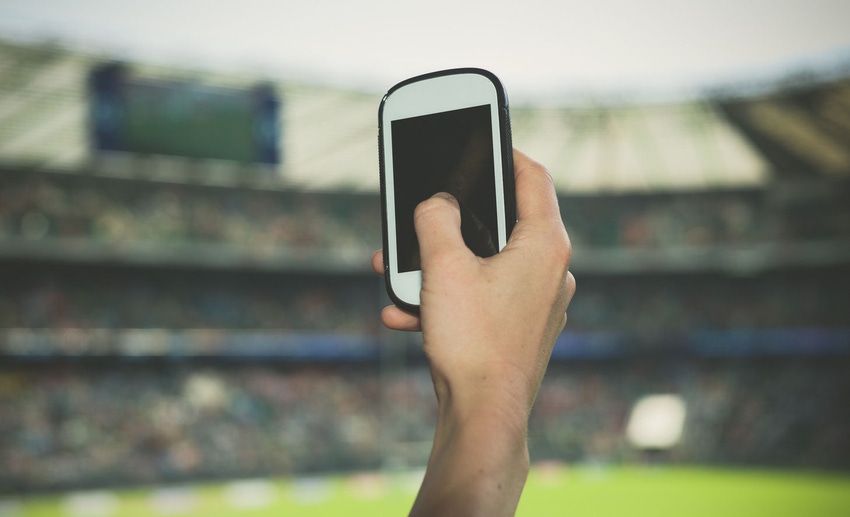Modern stadiums present unique challenges in the provision of wireless connectivity and capacity, however, with many lacking the necessary infrastructure, or needing an upgrade to handle rising demand.
July 6, 2015

Telecoms.com periodically invites expert third-party contributors to submit analysis on a key topic affecting the telco industry. In this article Markus Kalt, vice president, business operations – EMEA at CommScope, details the unique challenges in the provision of wireless connectivity and capacity in modern stadiums.
With 7.4 billion mobile devices in use around the world globally in 2014, it’s little surprise how reliant today’s sports fans are on their smartphones for up-to-the-minute team news, results and replays.
Whether filming and sharing a goal, enjoying multi-angle replays moments after an event, or simply messaging friends to check on a rival team’s results, supporters expect to be able to use their phone to interact with their team throughout a match. A flawless, high capacity wireless service is required throughout the stadium for them to do so however.
The significant amount of HD video being recorded and shared at matches has led to a high demand for bandwidth which, as innovations, applications and services are developed, will only continue to grow.
According to Cisco, mobile traffic in 2014 was almost 30 times the size of the global Internet in 2000, and is expected to increase nearly tenfold by 2019, when three quarters of it will consist of video content (72%).
German mobile operators recently upgraded Berlin’s Olympia Stadium ahead of the European Champions League final with what’s considered to be the most modern system in Germany. Providing 2G, 3G and 4G/LTE with MIMO, allowing multiple signals to be sent and received on the same radio channel, and supporting four frequency bands, the new system is designed to enhance capacity, and allows fans to upload high definition photos and videos, and access apps from their smartphones, at the same time as everyone else.
Club owners, stadium managers and network operators are, of course, aware of the commercial opportunities that this level of connectivity offers and know that, to capitalise on these potential new revenue streams, it’s no longer enough to simply provide visitors with a basic mobile connection.
To meet the increasing level expectations for a seamless mobile service and experience they need to invest in a robust network that’s capable of managing the communication and digital technology within the venue.
The unique challenges presented by modern stadiums
Modern stadiums present unique challenges in the provision of wireless connectivity and capacity, however, with many lacking the necessary infrastructure, or needing an upgrade to handle rising demand. The glass facades and futuristic aesthetics of these buildings hide a number of features that must be considered when planning the installation of a wireless system.
Mobile signals may be unable to penetrate a building’s thick concrete walls, for example, or negotiate its angles. The low emissivity window tinting used in modern green buildings can block signals as well as heat and light, and interference from outdoor macro networks and from between internal adjacent sectors can have an adverse effect.
These challenges are further compounded when tens of thousands of mobile users arrive at the venue on match day. The surge in demand could be so significant that the available data rate per user is reduced to such an extent that social media is no longer effective, possibly even resulting in a complete failure at peak times.
Essentially, the network required for match day is similar to that needed to support a small city, but within a single structure.
It’s clear that next generation technology should be kept in mind when designing and building a stadium’s communications systems, and that accommodating the phenomenal demand for bandwidth represents a series of significant challenges for those responsible.
Network of small antennas
Experienced engineers and designers know how challenging it can be to ensure that mobile reception floods every part of a stadium with sufficient capacity to support the bandwidth demands of thousands of mobile users while, at the same time, managing any interference. Where once only a few sectors were required for wireless coverage, it can now take up to 50 sectors to ensure the provision of adequate capacity.
A distributed antenna system (DAS) is the most commonly deployed solution for meeting the challenges of providing coverage and capacity within stadiums. DAS involves installing a network of small antennas, which act as repeaters, receiving digital signals from a dedicated base station and distributing them throughout the building via fibre or coaxial cable.
The number of antennas and the labour needed to install them and their connecting cables means deploying DAS can be an expensive project. To keep costs down, a single DAS can be shared by a number of carriers.
Traditionally DAS would be deployed by individual carriers who would be responsible for negotiating with a building’s owner, securing permits and authorities with local regulating authorities, funding the system’s deployment and managing it once deployed. To offset its operating costs, portions of the system’s resources would often be leased to other carriers.
Due to the increasing demand for ubiquitous connectivity, the number of DAS installations is expected to grow by 300 percent by 2017, with the cost of deployment and maintenance alongside it. The wireless industry is currently exploring a number of service delivery models to offset the capital and operating expenditure, one of which, the neutral host model, is receiving a lot of attention.
Neutral host model
With a neutral host DAS, the system’s ownership shifts from the carrier to the building’s owner, DAS integrator, or a third-party system provider who assumes all financial, regulatory, legal and technical responsibility for its deployment, installation and maintenance, as well as leasing space or access to the system to one or more operators.
The neutral host model benefits all parties involved. More end-users are able to use their own carrier’s network rather than roam if multiple carriers participate, none of whom will have an unfair advantage if the DAS is owned and managed by a third party. And besides, stadium owners looking to improve the experience of their visitors wouldn’t be interested in a solution that only worked for one mobile network.
While relatively new and still developing, the neutral host DAS model is likely to grow in popularity with carriers, venue owners, and integrators looking to cut deployment costs.
All sports fans have smartphones and expect to be able to use them for different purposes wherever they are, at any time. By supporting the growing number of applications and services running on wireless networks, stadium owners can capitalise on new commercial opportunities and improve match day for fans.
State-of-the-art wireless communication systems are no longer to be found only in the most high-tech venues – they are an essential part of any modern stadium experience.
 Markus Kalt is vice president of business operations for CommScope’s Distributed Coverage and Capacity Solutions team, responsible for the Europe, Middle East and Africa regions. Markus has more than 25 years of experience in the telecommunications industry, having worked in research and development, education, system engineering, product line management and business operations. He started as a system engineer for Andrew Corporation in 1992, taking on roles of greater responsibility for the distributed communication systems team.
Markus Kalt is vice president of business operations for CommScope’s Distributed Coverage and Capacity Solutions team, responsible for the Europe, Middle East and Africa regions. Markus has more than 25 years of experience in the telecommunications industry, having worked in research and development, education, system engineering, product line management and business operations. He started as a system engineer for Andrew Corporation in 1992, taking on roles of greater responsibility for the distributed communication systems team.
Read more about:
DiscussionAbout the Author(s)
You May Also Like








.png?width=300&auto=webp&quality=80&disable=upscale)


_1.jpg?width=300&auto=webp&quality=80&disable=upscale)


.png?width=800&auto=webp&quality=80&disable=upscale)